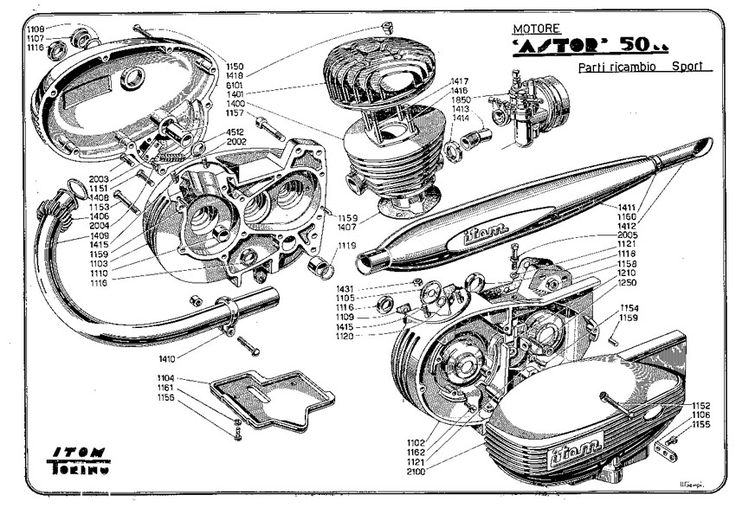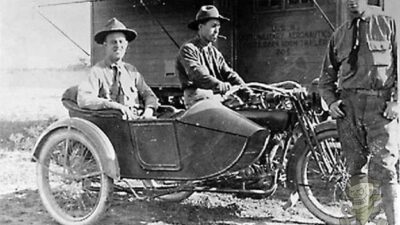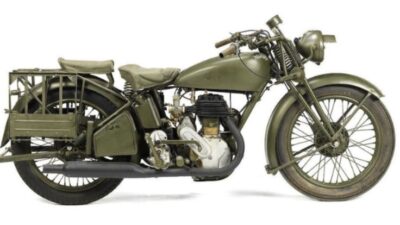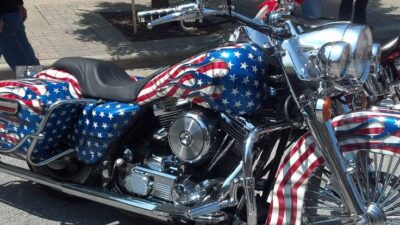The motorcycle engine has traveled a remarkable path from its humble beginnings in the late 1800s to the powerful machines we know today. Early motorcycle engines evolved from simple steam-powered attachments on bicycle frames to sophisticated internal combustion systems that laid the foundation for modern motorcycle technology. The history of motorcycle engine evolution tells a story of continuous innovation and improvement.

The first motorcycle engines were basic affairs, often producing just a few horsepower from tiny single-cylinder designs. Early motorcycle manufacturers like Harley-Davidson started production between 1901-1903, along with other pioneering companies that would shape the industry. These early powerplants were crude compared to today’s standards but represented groundbreaking technology for their time.
Understanding how these early engines developed helps explain why modern motorcycles perform the way they do. The innovations and challenges faced by early engineers created solutions that still influence motorcycle design today. From the first steam engines to the introduction of four-stroke technology, each advancement built upon previous discoveries.
Key Takeaways
- Early motorcycle engines transformed from steam-powered bicycle attachments into sophisticated internal combustion systems
- Pioneer manufacturers established the foundation for modern motorcycle technology through continuous experimentation and innovation
- The technological breakthroughs of early motorcycle engines directly influence the design and performance of today’s motorcycles
Origins of Motorcycle Engines

The first motorized two-wheelers emerged in the 1860s with steam-powered bicycles, followed by Gottlieb Daimler and Wilhelm Maybach’s groundbreaking internal combustion Reitwagen in 1885, and culminated with the Hildebrand & Wolfmüller becoming the first production motorcycle in 1894.
Steam-Powered Bicycles and the Dawn of Motorized Two-Wheelers
Steam-powered bicycles appeared in the 1860s as inventors began experimenting with adding engines to existing bicycle designs. The first steam powered motorcycle, the Michaux-Perreaux steam velocipede, traced back to 1867 when Ernest Michaux fitted a small steam engine to a velocipede.
Sylvester H. Roper developed a twin-cylinder steam velocipede in 1868 in Massachusetts. His machine featured a coal-fired boiler positioned between the wheels. French engineer Louis-Guillaume Perreaux patented a similar steam-powered single cylinder machine the same year with an alcohol burner and twin belt drives.
Key Steam Engine Features:
- Coal or alcohol-fired boilers
- Twin cylinder designs
- Belt drive systems
- Boiler placement between wheels
Lucius Copeland created a smaller steam boiler in 1881 that could drive a high-wheeler bicycle at 12 mph. He later formed the Northrop Manufacturing Co. in 1887 to produce the first successful three-wheeled ‘Moto-Cycle’.
The Reitwagen: The First Internal Combustion Motorcycle
Gottlieb Daimler and Wilhelm Maybach built the first internal combustion, petroleum fueled motorcycle called the Petroleum Reitwagen in Bad Cannstatt, Germany in 1885. This machine is widely recognized as the first motorcycle, earning Daimler the title “father of the motorcycle.”
The Reitwagen differed significantly from bicycles of that era. It had zero degrees of steering axis angle and no fork offset, meaning it didn’t use standard bicycle dynamics principles. Instead, it relied on two outrigger wheels to stay upright while turning.
Reitwagen Specifications:
- Engine Type: Single-cylinder internal combustion
- Fuel: Petroleum
- Stability: Two outrigger wheels
- Purpose: Testbed for new engine technology
The inventors called their creation the Reitwagen, meaning “riding car” in German. They designed it as an expedient testbed for their new engine rather than a true prototype vehicle for mass production.
Hildebrand & Wolfmüller and the First Production Motorcycle
The Hildebrand & Wolfmüller became the first series production motorcycle in 1894 and was the first machine officially called a “motorcycle” (German: Motorrad). This milestone marked the transition from experimental machines to commercial motorcycles.
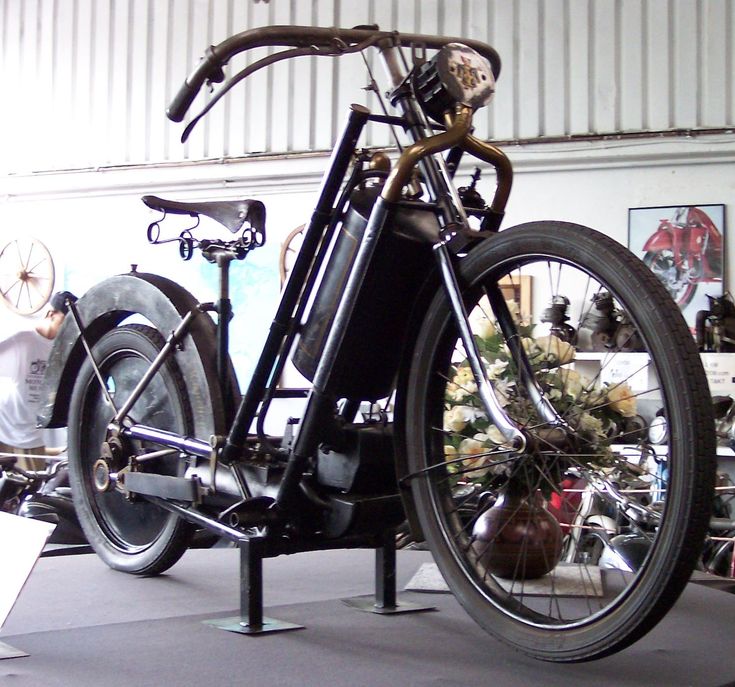
Only a few hundred examples of this pioneering motorcycle were ever built. Despite its limited production numbers, it established important precedents for the motorcycle industry. The term “motor cycle” appeared in English the same year in materials promoting machines developed by E.J. Pennington.
The Hildebrand & Wolfmüller featured advanced engineering for its time. It used a twin-cylinder four-stroke engine connected directly to the rear wheel. The machine eliminated pedals entirely, making it a true motorcycle rather than a motorized bicycle.
Production Timeline:
- 1894: First series production begins
- Limited run: Only hundreds produced
- Legacy: Established motorcycle manufacturing principles
Technological Milestones in Early Motorcycle Engine Evolution

Early motorcycle development centered around three major engine innovations that transformed simple motorized bicycles into practical machines. The progression from basic single-cylinder designs to sophisticated four-stroke and two-stroke systems established the foundation for modern motorcycles.
Single-Cylinder Engines and Early Designs
The first true motorcycle created by Gottlieb Daimler and Wilhelm Maybach in 1885 featured a single-cylinder engine attached to a bicycle frame. This design became the standard for early motorcycle development.
Single-cylinder engines offered several advantages for early manufacturers. They were simple to build and maintain. The design required fewer moving parts than multi-cylinder alternatives.
Key Features of Early Single-Cylinder Engines:
- Displacement: 100-500cc typically
- Power output: 1-3 horsepower
- Fuel delivery: Carburetor-based systems
- Ignition: Hot tube or early spark plug systems
These engines used atmospheric intake valves that opened by suction. The exhaust valve operated mechanically through cam systems. Most early single-cylinder designs ran at relatively low RPMs due to metallurgy limitations.
Manufacturers like Indian and early Harley-Davidson refined single-cylinder technology throughout the 1900s. They improved cooling systems and fuel delivery methods. These advances made motorcycles more reliable for daily transportation.
Adoption of Four-Stroke Engines
Four-stroke engines became the dominant technology in early motorcycle development due to their efficiency and reliability. The four-stroke cycle includes intake, compression, power, and exhaust strokes that occur over two crankshaft revolutions.
Early four-stroke motorcycle engines solved many problems of primitive two-stroke designs. They burned fuel more completely and produced less smoke. The engines also ran more smoothly at various speeds.
Four-Stroke Engine Advantages:
- Better fuel economy
- Lower emissions
- More consistent power delivery
- Longer engine life
The introduction of V-twin engines in the 1910s marked a major advancement in four-stroke technology. These engines offered greater power and reliability than single-cylinder designs. V-twin configuration became synonymous with American motorcycle brands.
Four-stroke engines required more complex valve systems than two-stroke alternatives. Early designs used inlet-over-exhaust valve arrangements. This system placed intake valves above exhaust valves in the cylinder head.
Manufacturers developed better metallurgy and machining techniques to support four-stroke technology. Improved materials allowed higher compression ratios and better performance.
Emergence of Two-Stroke Engines
Two-stroke engines appeared in early motorcycles as an alternative to four-stroke designs. These engines complete their power cycle in just two piston strokes instead of four. This design made them lighter and simpler than four-stroke alternatives.
The two-stroke cycle combines intake and compression in the first stroke. Power and exhaust occur during the second stroke. This design eliminates the need for complex valve systems found in four-stroke engines.
Two-Stroke Engine Characteristics:
- Simpler construction
- Higher power-to-weight ratio
- More frequent power pulses
- Mixed oil and fuel lubrication
Early two-stroke motorcycle engines used ports in the cylinder walls instead of valves. The piston itself acted as a valve by covering and uncovering these ports during operation. This design reduced manufacturing costs significantly.
Two-stroke engines produced more power per displacement than four-stroke designs. They delivered power on every crankshaft revolution instead of every other revolution. This characteristic made them popular for lightweight motorcycles and racing applications.
However, early two-stroke engines consumed more fuel and oil than four-stroke alternatives. They also produced more exhaust emissions due to incomplete combustion. Despite these drawbacks, two-stroke technology remained important in motorcycle development through the early decades.
Rise of Pioneering Motorcycle Manufacturers

The early 20th century marked the establishment of legendary motorcycle brands that would shape the industry for decades to come. Indian Motorcycle Manufacturing Company became the first American motorcycle brand in 1901, followed by Harley-Davidson’s entry into production just one year later.
The Birth of Harley-Davidson
Harley-Davidson began producing motorcycles in Milwaukee, Wisconsin in 1902. The company started as a small operation founded by William Harley and Arthur Davidson in a modest shed.
Their first motorcycles featured simple single-cylinder engines attached to bicycle frames. These early models prioritized reliability over speed or comfort.
By 1903, the company had produced its first complete motorcycle. The machine used a small engine that required pedaling to help it up hills.
Key Early Features:
- Single-cylinder engines
- Belt-driven systems
- Basic carburetor designs
- Wooden frame construction
The company’s focus on durability made their motorcycles popular for both civilian and military use. During World War I and II, Harley-Davidson produced bikes for military applications, including the robust WLA model known for its battlefield reliability.
Mainstream Adoption and Brand Competition
The early 1900s witnessed the rise of famous motorcycle brands including Harley-Davidson, Indian, and Triumph. These companies began producing larger and more powerful motorcycles suitable for racing and daily transportation.
Major Innovations Introduced:
- Electric starter systems
- Advanced suspension designs
- Improved braking mechanisms
- Multi-cylinder engines
Competition drove rapid technological advancement among manufacturers. Each brand developed unique engine designs and features to attract different types of riders.
Indian Motorcycle Manufacturing Company emerged as Harley-Davidson’s primary American competitor. The rivalry pushed both companies to improve their engine technology and manufacturing processes.
European manufacturers like Triumph brought their own innovations to the market. This international competition accelerated the development of more sophisticated engine designs and manufacturing techniques.
These pioneering manufacturers established themselves by creating models that appealed to both performance enthusiasts and everyday users. Their success laid the foundation for the modern motorcycle industry.
Key Innovations Impacting Engine Development

The electric starter eliminated the dangerous kick-starting process that plagued early motorcycles, while advanced suspension systems allowed engines to operate more efficiently by reducing vibrations and maintaining better contact with the road surface.
Introduction of the Electric Starter
The electric starter represented one of the most significant safety and convenience improvements in early motorcycle engine development. Before this innovation, riders had to use kick starters or hand cranks to start their engines.
These manual starting methods posed serious risks. Kick starters could violently snap back and injure riders’ legs. Hand cranks sometimes caused broken wrists or arms when engines backfired unexpectedly.
Electric starters first appeared on motorcycles in the 1960s. They used a small electric motor powered by the motorcycle’s battery to turn the engine crankshaft. This system made starting much safer and more reliable.
Key benefits of electric starters included:
- Eliminated physical injury risks from kickback
- Allowed easier starting in cold weather
- Made motorcycles accessible to more riders
- Reduced wear on engine components from violent kick starting
The technology required improvements in battery design and charging systems. Manufacturers had to create more powerful batteries that could handle the high current draw of starter motors while still powering lights and ignition systems.
Advancements in Suspension Systems
Suspension systems directly impacted engine performance by controlling how engines transferred power to the road. Early motorcycles used rigid frames with no suspension, causing engines to experience constant jarring and vibration.
The introduction of front forks with springs in the 1930s marked the first major advancement. These systems absorbed road impacts and prevented excessive engine vibration that could damage internal components.
Rear suspension development followed in the 1940s and 1950s. Swingarm designs with shock absorbers allowed the rear wheel to move independently of the engine and frame. This reduced stress on engine mounts and transmission components.
Modern suspension improvements included:
- Telescopic forks – Provided smoother compression and rebound
- Adjustable damping – Allowed tuning for different riding conditions
- Progressive springs – Offered varying resistance based on compression
Better suspension systems enabled engines to maintain consistent power delivery. The rear wheel stayed in better contact with the road surface, improving traction and reducing power loss during acceleration.
Advanced suspension also allowed engineers to design more powerful engines. The improved vibration control meant internal engine components experienced less stress and lasted longer.
Transition from Early Engines to Modern Motorcycles

The journey from primitive steam-powered velocipedes to today’s advanced motorcycles involved major breakthroughs in engine performance and construction materials. These improvements transformed unreliable experimental machines into the dependable, powerful motorcycles riders use today.
Performance and Reliability Improvements
Early motorcycle engines suffered from frequent breakdowns and limited power output. The first steam-powered motorcycles like the 1867 Roper Steam Velocipede were unreliable and dangerous.
The introduction of four-stroke engines changed everything. Nikolaus Otto’s 1876 four-stroke design became the foundation for modern motorcycle engines. This system provided:
- Better fuel efficiency
- More consistent power delivery
- Reduced mechanical failures
- Cleaner combustion
Modern four-stroke engines now power most motorcycles from Harley-Davidsons to high-performance Japanese bikes. These engines convert fuel to motion through four precise piston movements instead of the two-stroke’s simpler but less efficient cycle.
Valve systems also improved dramatically. Early engines used basic intake methods. Modern motorcycles typically feature four valves per cylinder with precise timing controls that maximize airflow and exhaust removal.
Material Advances and Design Evolution
Engine materials evolved from basic cast iron to advanced alloys. Early motorcycle engines were heavy and prone to overheating. Modern engines use lightweight aluminum blocks and steel components that handle extreme temperatures.
Cooling systems advanced from simple air cooling to sophisticated liquid cooling. Alfred Angas Scott created the first water-cooled motorcycle in 1908. Today’s cooling systems use radiators, coolant pumps, and thermostats.
Key material improvements include:
| Component | Early Design | Modern Design |
|---|---|---|
| Engine Block | Cast Iron | Aluminum Alloy |
| Pistons | Heavy Steel | Lightweight Alloy |
| Valves | Basic Steel | Heat-Resistant Steel |
| Cooling | Air Only | Liquid Systems |
Electronic fuel injection replaced carburetors in most modern motorcycles. This change improved fuel economy and reduced emissions. Computer-controlled ignition systems now provide precise spark timing that early engines could never achieve.
Modern motorcycles also feature multiple cylinders arranged in various configurations. Single-cylinder engines gave way to twin, triple, and four-cylinder designs that produce more power while running smoother than their ancestors.
The Lasting Influence of Early Motorcycle Engines

Early motorcycle engines created engineering principles that still guide modern bike design today. These pioneering power plants also established cultural traditions that continue to shape how riders view and modify their motorcycles.
Foundation for Modern Engineering
The fundamental concepts developed in early motorcycle engines remain essential to modern bike design. Single-cylinder engines from the 1880s established the basic four-stroke cycle that powers most motorcycles today.
Early engineers solved critical problems that modern designers still face. They figured out how to balance power with weight. They developed cooling systems that prevented overheating. They created transmission systems that transferred power to wheels effectively.
Key engineering principles from early engines:
- Four-stroke combustion cycles
- Air and oil cooling methods
- Chain and belt drive systems
- Carburetor fuel mixing
- Ignition timing systems
The 1905 FN Four’s inline cylinder arrangement became the template for modern sport bikes. Its balanced design reduced vibration problems that plagued single-cylinder engines.
V-twin configurations from companies like Harley-Davidson proved that engine layout affects both performance and sound. This understanding led to today’s diverse engine types designed for specific riding styles.
Modern fuel injection systems evolved from early carburetor designs. Electronic ignition systems improved on mechanical timing methods. Even electric motorcycles use mounting techniques and weight distribution lessons learned from steam and gas engines over 100 years ago.
Legacy in Today’s Motorcycle Culture
Early motorcycle engines created cultural traditions that define riding communities today. The distinctive sound and feel of different engine types became part of rider identity.
Harley-Davidson’s 45-degree V-twin established the connection between engine sound and brand loyalty. Riders still choose motorcycles partly based on how the engine sounds and feels. This emotional connection started with early engines that had unique characteristics.
Single-cylinder “thumpers” from the early 1900s influenced modern dirt bike culture. Their simple design and easy maintenance appealed to riders who worked on their own bikes. Today’s adventure and dual-sport riders value these same qualities.
The reliability proven by early four-cylinder engines like the 1969 Honda CB750 convinced riders that motorcycles could be daily transportation. This changed how people viewed bikes from weekend toys to practical vehicles.
Custom motorcycle culture traces back to early riders who modified their engines for better performance. Hot rodding techniques developed for early motorcycle engines became the foundation for today’s performance modification scene.
The “cafe racer” movement honors early racing motorcycles that used lightweight frames and tuned engines. Modern retro bikes deliberately copy styling and engine characteristics from motorcycles built 50 to 70 years ago.
Frequently Asked Questions

Early motorcycle engines underwent major changes from steam-powered beginnings to sophisticated internal combustion systems. Key developments included the shift from single-cylinder to multi-cylinder designs and advances in fuel delivery systems that improved both power and reliability.
What are the key differences between the earliest motorcycle engines and those from the later classic period?
The earliest motorcycle engines were simple single-cylinder designs with basic carburetion systems. These primitive engines produced limited power and required frequent maintenance.
Later classic period engines featured improved metallurgy and more precise manufacturing. They incorporated better cooling systems and more reliable ignition methods.
Multi-cylinder configurations became standard in the classic period. This design change provided smoother power delivery and increased overall performance compared to early single-cylinder models.
How did technological advancements in the early 20th century influence motorcycle engine design?
Mass production techniques allowed manufacturers to create more consistent engine components. This standardization improved reliability and reduced manufacturing costs significantly.
Advances in metallurgy introduced stronger materials for engine construction. Steel alloys and improved casting methods enabled engines to withstand higher compression ratios and operating temperatures.
The development of better machining tools resulted in tighter tolerances. More precise cylinder bores and piston fits reduced oil consumption and increased engine efficiency.
What role did the development of internal combustion engines play in the evolution of motorcycles?
Internal combustion engines replaced the early steam-powered motorcycle prototypes of the 1860s. This transition eliminated the need for heavy boilers and water tanks.
Gasoline engines provided a much better power-to-weight ratio than steam systems. Riders could travel longer distances without stopping to refuel or add water.
The four-stroke cycle became the dominant design for motorcycle engines. This configuration offered better fuel efficiency and cleaner combustion than two-stroke alternatives.
How did the adoption of multi-cylinder engines change the performance and popularity of early motorcycles?
Single-cylinder engines produced significant vibration and uneven power delivery. Multi-cylinder designs distributed power pulses more evenly throughout the engine cycle.
V-twin and inline twin configurations became popular choices for larger motorcycles. These layouts provided more power while maintaining reasonable engine dimensions.
Smoother operation made motorcycles more appealing to a broader range of riders. Reduced vibration improved comfort during longer rides and increased overall reliability.
In what ways did the need for more power and reliability drive the evolution of motorcycle engines in racing?
Racing competitions pushed manufacturers to develop stronger engine components. High-performance racing revealed weaknesses in standard engine designs quickly.
Competition engines featured improved valve systems and higher compression ratios. These modifications increased power output but required premium fuels and precise tuning.
Racing success became a marketing tool for motorcycle manufacturers. Performance improvements developed for racing eventually appeared in production motorcycles.
What are the significant milestones in the development of fuel systems and efficiency in motorcycle engines?
Early motorcycles used simple gravity-fed fuel systems with basic carburetors. These systems worked adequately for low-performance engines but limited power potential.
Float-bowl carburetors provided more consistent fuel delivery across different operating conditions. This improvement allowed engines to maintain proper fuel mixture at various speeds.
Multiple carburetor setups appeared on high-performance engines. Twin-carburetor systems improved fuel distribution in multi-cylinder engines and increased overall power output.
